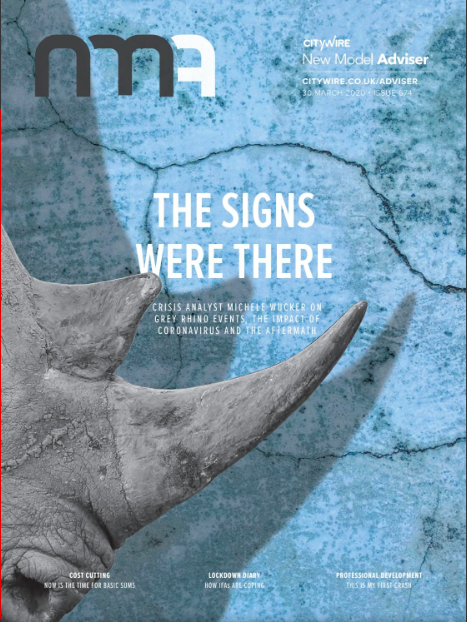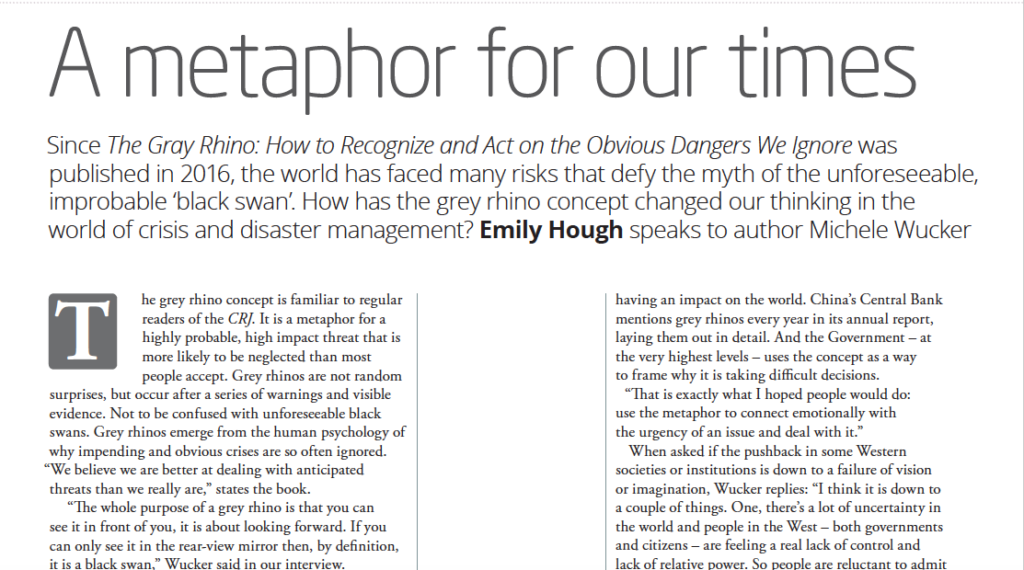If the nobody-could-have-seen-it-coming black swan metaphor was the narrative of the 2008 market meltdown, the highly probable, obvious “gray rhino” metaphor tells the story of the crisis we are in today.
Amid the double calamities of the COVID-19 pandemic and market meltdown, both of which followed repeated public warnings that went ignored, the gray rhino has struck a chord and generated a flood of headlines around the world.

Crisis Response Journal recently called the gray rhino “A metaphor for our times.” The UK financial magazine, New Model Advisor, made the gray rhino the cover story of its new issue, relegating the black swan to a sidebar.
Nassim Taleb, who coined the term “black swan” for highly improbable and unforeseeable events, has declared on twitter and in multiple interviews, including on Bloomberg News, that the combined pandemic and financial crisis was and is not a black swan. It was neither unforeseeable nor even improbable. (He has suggested “white swan,” but that makes no sense because, at least in Europe and North America, a white swan simply is a normal swan. And this crisis is anything but normal.)
Gray Rhino & Company CEO Michele coined the term “gray rhino” to draw attention to the obvious risks that are neglected despite – indeed, often because of– their size and likelihood. The gray rhino metaphor, developed in her 2016 best-seller, THE GRAY RHINO: How to Recognize and Act on the Obvious Dangers We Ignore, has moved markets, shaped financial policies, and made headlines around the world, particularly involving China’s financial risk strategy.
Michele’s recent Washington Post op-ed challenged the tired black swan trope that has given portfolio managers and policy makers a convenient “nobody saw it coming” cop-out when they ignore obvious dangers: “Let’s trade the black swan for the gray rhino: a mind-set that holds ourselves and our government accountable for heeding warnings and acting when we still have a chance to change the course of events for the better instead of waiting for a crisis to act.” The Wall Street Journal quoted that article, offering the gray rhino as an alternative to the black swan.
Axios, Fast Company, and The Economist’s The World Ahead podcast have adopted the gray metaphor to describe this crisis. The term also has made pandemic and financial collapse related headlines in The Daily Australian; CGTN, China Daily, Caixin Global, South China Morning Post, and many, many others in greater China); Nikkei and Chuo Nippo (Japan); Newspim, Aju Economic Newspaper, Korea Business Watch, Energy Economy, (South Korea); SG Money Matters, Singapore; Khmer Times (Cambodia); The Business Recorder (Pakistan); South Asia Journal (Sri Lanka); The Standard podcast (Thailand); The Arab Weekly; The Daily Maverick (South Africa); Daily Monitor (Uganda); De Limburger (Belgium); Finans (Denmark); Le Monde (France); Wall Street Weekly (Germany); Finanza Online (Italy); El Confidencial and Moda (Spain); Neue Zuercher Zeitung (Switzerland); Ethnos and Ta Nea (Greece), Hospodářské noviny and Kryptomagazin (Czech Republic); La Tercera (Chile); El Nacional (Venezuela); The Hill Times and La Presse (Canada); and Megalopolis and El Espectador (Mexico).
The black swan has been misused to normalize complacency. By contrast, the gray rhino provides an alternative that challenges decision makers to be held accountable for failing to prepare for and head off clear and present dangers.
It provides not only a new way to think about the twin pandemic and financial crises, but also a framework for how we can do a better job holding decision makers accountable when they fail to keep threats from turning into catastrophes. As Crisis Response Journal put it, the gray rhino is indeed a metaphor for our times.
- The Gray Rhino Wrangler on Substack - January 1, 2025
- Gray Rhino Risks and Responses to Watch in 2024 - January 10, 2024
- In the Media 2023 - December 31, 2023


